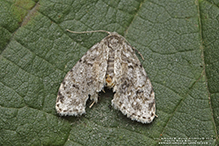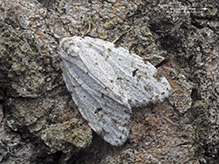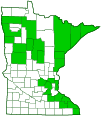little white lichen moth
(Clemensia albata)
Conservation • Description • Habitat • Ecology • Distribution • Taxonomy
|
||||||||
| Hodges # | 8098 |
|||||||
Conservation Status |
||||||||
| IUCN Red List | not listed |
|||||||
| NatureServe | NNR - Unranked SNR - Unranked |
|||||||
| Minnesota | not listed |
|||||||
Description |
||
Little white lichen moth, as the common name suggests, is a small moth. It occurs in the United States east of the Great Plains and on the West Coast, and across southern Canada. It is common in the eastern third of Minnesota, where it is at the western extent of its range, but absent in the remainder of the state. Adults are found from mid-July to early August in moist, mixed and deciduous forests and woodlands. Larvae feed on shield lichens growing on trees and large shrubs, or on green algae (Protococcus viridis) growing on those lichens, or both. They may be consuming lichen for the algae growing on it. Adults are ⅜″ to ½″ (9 to 13 mm) in length and have a ⅝″ to 15⁄16″ (16 to 24 mm) wingspan. The forewings are broadly rounded on the outer margin. They are white and finely peppered and spotted with black and brown. They are crossed by six transverse lines that are mostly brown with black spots. From the wing base to the tip these are a basal line, an antemedial (AM) line, a median line, a postmedial (PM) line, a subterminal (ST) line, and a terminal line. The AM and median lines are usually distinct, the basal, PM and ST lines are usually obscure. The median line is wavy, appearing as a broad W crossing both wings. The terminal line is represented as a series of dashes. There are six black spots on the leading (costal) margin from the wing base to near the wing tip. Each spot is at the end of one of the transverse lines. There is a round spot (orbicular spot) in the upper median area and kidney-shaped spot (reniform spot) between the median line and PM line. The orbicular spot is a small black dot. The reniform spot is large and conspicuous. The upper half is black and crescent shaped, the lower half is gray or light brown and touches the ST line. The hindwing is white and light gray. The antennae are slender and thread-like. The caterpillar is dark green, mottled with black, white, and yellow, and has a thin white line above in the middle (middorsal). It has sparse hairs (setae) growing from bumps on each upper side (subdorsal) of each abdominal segment. |
||
Size |
||
Total length: ⅜″ to ½″ (9 to 13 mm) Wingspan: ⅝″ to 15⁄16″ (16 to 24 mm) |
||
Similar Species |
||
Habitat |
||
Moist, mixed and deciduous forests and woodlands. |
||
Ecology |
||
Season |
||
One generation per year: Mid-July to early August |
||
Behavior |
||
|
||
Life Cycle |
||
The pupa overwinters. |
||
Larva Hosts |
||
Most authors state that this moth feeds on tree lichens. However, a description published in 1981 (McCabe) reports it feeding on green algae (Protococcus viridis) and refusing lichens. Protococcus viridis grows on shield lichens on trees. The larvae may be consuming lichen for the algae growing on it. |
||
Adult Food |
||
|
||
Distribution |
||||
|
Sources |
|||
| 1/14/2023 | ||||
Occurrence |
||||
Common in eastern Minnesota |
||||
Taxonomy |
|||
Order |
Lepidoptera (Butterflies and Moths) | ||
Superfamily |
Noctuoidea (Owlet Moths and Allies) | ||
Family |
Erebidae (Underwing, Tiger, Tussock, and Allied Moths) | ||
Subfamily |
Arctiinae (tiger moths and allies) | ||
Tribe |
Lithosiini (lichen moths) | ||
| Subtribe | Cisthenina | ||
Genus |
Clemensia | ||
In 2011 the family Arctiidae (tiger moths and lichen moths) was transferred to the family Erebidae mostly intact but demoted to a subfamily. The former subfamilies are now tribes, the former tribes now subtribes. |
|||
Synonyms |
|||
|
|||
Common Names |
|||
little white lichen moth |
|||
Glossary
Antemedial (AM) line
A thin line separating the basal area and the median area of the forewing of Lepidoptera.
Costal margin
The leading edge of the forewing of insects.
Orbicular spot
A circular spot or outline in the upper median area near the antemedial line on the forewing of many moths.
Postmedial (PM) line
A thin line separating the median area and the postmedial area of the forewing of Lepidoptera.
Reniform spot
A kidney-shaped spot or outline in the lower median area near the PM line on the forewing of many moths.
Seta
A stiff, hair-like process on the outer surface of an organism. In Lepidoptera: A usually rigid bristle- or hair-like outgrowth used to sense touch. In mosses: The stalk supporting a spore-bearing capsule and supplying it with nutrients. Plural: setae. Adjective: setose.
Visitor Photos |
|||||
Share your photo of this insect. |
|||||
| This button not working for you? Simply email us at info@MinnesotaSeasons.com. Attach one or more photos and, if you like, a caption. |
|||||
Alfredo Colon |
|||||
 |
 |
||||
MinnesotaSeasons.com Photos |
|||||
|
|||||

Slideshows |
||

Visitor Videos |
|||
Share your video of this insect. |
|||
| This button not working for you? Simply email us at info@MinnesotaSeasons.com. Attach a video, a YouTube link, or a cloud storage link. |
|||
Other Videos |
|||
| Little White Lichen Moth (Erebidae: Clemensia albata) on Wall Carl Barrentine |
|||
About
Jul 12, 2011 Photographed at Fisher, Minnsota (12 July 2011). Thank you to Libby and Rick Avis (@Bugguide.net) for confirming the identity of this specimen! |
|||

Created: 12/17/2020
Last Updated:



